Recent Posts
-
It IS Happening Here
February 16, 2024
-
General Ludd to General Intellect
January 11, 2024
-
Temporal and Geographic Edges
December 26, 2023
-
The Root of All Evil
October 13, 2023
-
Post-Pandemic Melancholia . . . Same As It Ever Was?
September 3, 2023
-
Chronicle of Deaths Foretold
June 24, 2023
-
Reparations is the Least We Should Do
May 11, 2023
-
We Are Not Alone
April 9, 2023
-
War and Anti-War
February 22, 2023
-
For Full Enjoyment, Not Full Employment!
January 7, 2023
|
“Dredgefest” appeared out of the blue in an email a couple of months ago, a title I couldn’t resist. I taught a class at the SF Art Institute a couple of years ago called “Dredge” so I didn’t think twice before signing up for their Saturday June 18 bus tour of bay shoreline sites. I was not disappointed! The tour visited three locations, Hamilton Field in Marin County, Sears Point National Wildlife Refuge on the northern shore of San Pablo Bay due south of the intersection of Highway 37 and the Lakeville Highway, and finally the Cullinan Ranch restoration project just west of Mare Island near Vallejo. Each site is former military and agricultural land being returned to marshland, with differing levels of deliberate design and engineering interventions.
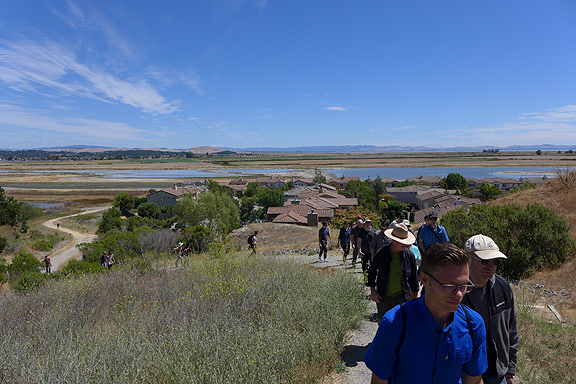 A full bus load of mud lovers, bird watchers, landscape engineers, hydrologists, citizen scientists, and radical librarians climbing a low ridge above Hamilton Field, once an airforce base with below sea level runways, now a showcase restoration project on the Marin County bay shore. 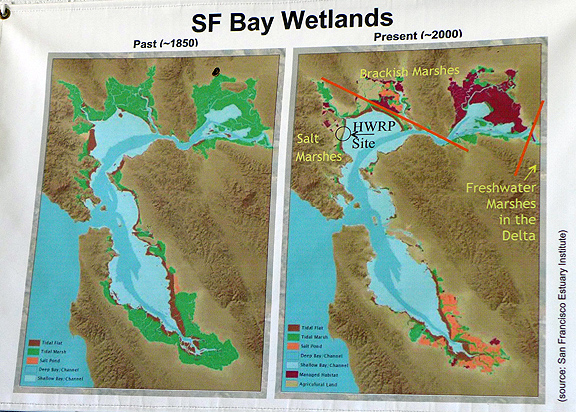 In the native plant nursery at Hamilton Field some helpful maps helped situate us. HWRP is the Hamilton Field Wetlands Restoration Project. 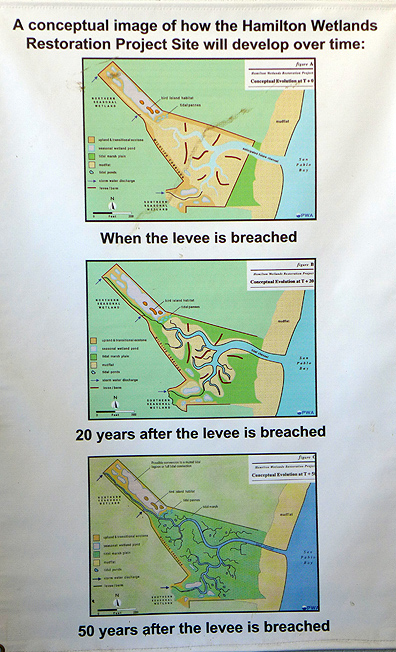 This is the closely designed plan for the former air base. For two years, 24/7, dredge materials from excavation at the Port of Oakland was pumped through an “Aquatic Transfer Device” specifically designed for this project (with a dedicated substation to provide enough power to run two 700 horsepower pumps fulltime) into the site to help contour the lands to become tidal marshes as soon as possible after the 2014 dike breach. Not only did the project carry out the dike breach on schedule in 2014 but apparently natural processes are in fact developing largely as planned. Against all odds, things are going very well! 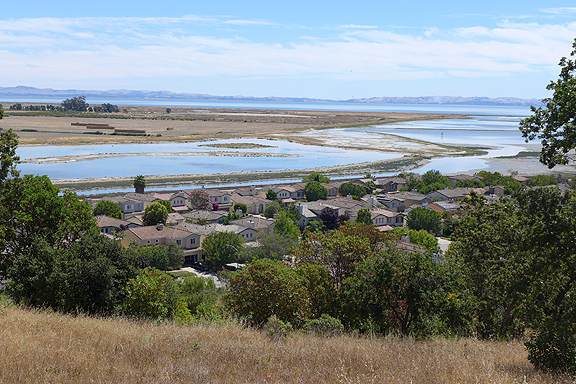 A variety of berms and data gathering stations help marshland dynamics re-emerge while providing the measurements to help the biologists and hydrologists figure out what went right and what didn’t. As you can see in the previous photo, the Hamilton Field restoration also includes parcels dedicated to suburban housing development. We were treated to detailed explanations of the ten-year multi-agency effort to raise the underlying lands enough to allow for successions of plant and animal life to flourish in the new/old wetlands. But the technical discussions of landscape design didn’t impress me as much as the remarkable story of bureaucratic cooperation and adaptation to overcome an endless series of budgetary, jurisdictional, political, and conceptual disputes. Unlikely coordination was achieved between the Army Corps of Engineers, the Port of Oakland, the Bay Conservation and Development Commission, the California Coastal Conservancy, the California State Water Board, the California State Lands Commission, California Fish and Wildlife, NOAA Fisheries, the Environmental Protection Agency, and more that I can’t remember.
The key to the Hamilton Field project was getting the dredge materials from the Port of Oakland, where the Army Corps is responsible for maintaining channel depths, and since it was decided to lower the channel depths from 42′ to 50′ to accommodate the new massive container ships, the Port and the Corps had a huge disposal problem. The Hamilton Field restoration project is one of the first to successfully use millions of cubic yards of bay dredge material to implement plans to remake historic marshlands. Until a decade ago, many environmental groups were opposed to the concept, assuming that it was a ruse to allow industry to dump toxic dredge with a “greenwashing” cover story. But according to the participant-experts who explained the project to us, the successful remaking of flourishing habitat for endangered species has won over most if not all of the critics and muted opposition to expanded efforts on other bayshore sites.
Continue reading Remaking Baylands While Preparing for Sea-level Rise
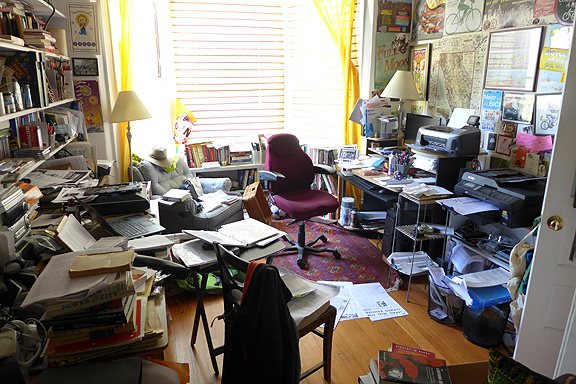 My poor cluttered office! I spend most of my time here these days, sitting amidst piles of books and papers, never with less than three or four projects underway simultaneously.
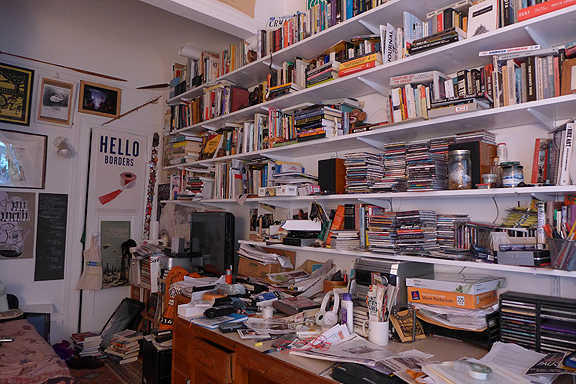 And this is just part of this wall, with the opposite wall also full of books, and several 6′ shelves outside in the hall… yes I have too many books! I’ve begun a research push for a new book I’m working on. More to come on that when it starts to feel real. If things go well, I’ll have a draft by early next year. Meanwhile, I’m still writing a lot of essays for various others, either on local history, or in this case, for a small bicycling magazine in Santiago, Chile called Revista Pedalea. Regrettably, their website seems to have a virus and I can’t access it at the moment, but hopefully the Spanish version of this short piece will be back up soon.
I’m in a Hurry . . . to Slow Down!
As an urban cyclist for the past 40 years, I have seen the world around me change considerably. My initial impetus for choosing to cycle instead of using cars or public transit was my frustration with traffic congestion, underfunded and inadequate buses and trains, and a general impatience. I hate to wait! On my bicycle I could arrive at my destination in less time than going by car or bus, and I had none of the agony of searching for parking that my friends suffered through. As a young man, I would speed through city streets, recklessly weaving in and out of traffic with a sense of invulnerability, and by good fortune, I never suffered any serious collisions in all these years.
In the late 1970s mobile phones were only a science fiction fantasy. The internet had not yet emerged as a common space of communication (even if it was taking shape behind the scenes), and for many people it was still a point of new convenience to have an answering machine attached to their home phone. To visit friends it was common to go across the neighborhood to knock on their door to see if they were home, without knowing if they would be. In 2016, we hardly have time to see our friends. If we want to meet up it takes several emails and phone calls, and a dozen text messages, and finally we agree that our schedules will allow us to meet in three weeks for 20 minutes to share a quick coffee! What happened?
In the 1970s, the world economy was still largely nation-based with most of the goods for daily life produced within the boundaries of our own countries. In the last decades of the 20th century and first part of the 21st century, the world market completely altered our lives. Now, most of the goods we consume are produced in far-away factories across the ocean. Money is speeding around the planet 24 hours a day at light-speed, seeking the most profitable opportunities in every obscure nook and cranny. More people have been uprooted from their traditional homes than at any previous time in world history. The iron dictatorship of money pushes them to seek better economic opportunities within countries and across national frontiers (legally or not). Our own lives have been reshaped by these dynamics. Whether we relocated or stayed put, we too have endured an enormous “speed-up” of daily life. Especially in the past 20 years, our lives have accelerated in ways no one could have anticipated.
Where I live in San Francisco at the epicenter of the much-heralded “tech boom,” everyone is so busy all the time that friendships are fraying and many don’t have time for a “real relationship.” The speed-up we are living through is treated as somehow inevitable, like the weather, and in any case, our adaptation to it is necessary if we want to be employed and have “a future!” People rush from work to eat to sleep and have little time for anything else. The eight-hour day that our ancestors fought such bitter battles to establish is a forgotten relic of the industrial era. Nowadays it is common to work 12-14 hours a day, including the time commuting on wi-fi equipped buses and trains.
The bicycle has become a sanctuary from this madness. On my bicycle I am not plugged in. I am in my head, I control how fast I move through the city, and I can take any opportunity along my route to stop and talk with friends or passersby who I happen to encounter. While it is still true that I can cross the city faster on a bicycle than many can by car or bus, the bicycle has come to represent a different pace of life, a slower form of movement. In this case, ‘slow’ refers less to velocity than to a philosophy of life. In a world that pushes us incessantly to work longer, more intense hours, to spend more and more time dedicated to expanding our skills and making ourselves ever more employable, the bicycle provides a rare opportunity to “check out” of this rat-wheel and reconnect to our own thoughts. Moreover it allows us to fully experience the air, the rain, the sounds, and the smells of the City that we miss when locked in the glass-and-metal boxes that clog the streets while dirtying our air and water.
When bicycling we experience life directly, without the mediation of corporate or government propaganda on the radio that dominate the driving experience. We can talk to people we meet, find out what’s going on at a demonstration, a collision, a scene of police or political action, without having it framed and explained by editors working for the owners of society. Bicycling through urban environments challenges our intellectual capacities to interpret reality directly, to arrive at understandings and explanations based on our own ideas and immediate knowledge rather than relying on the hysterical and distorted reporting that passes as “news” in most of the “free world.”
Time slows down when you are lost in your thoughts. Bicycling is one of the activities that cost us practically nothing and yet gives us so much. We can step off the speeding treadmill of daily life for a precious half hour or more to taste the city’s forgotten flavors, to think our own thoughts, and to determine our own pace.
We living in a globe-spanning culture that wants to reduce everything to the degrading slogan Time is Money! Well, time has run out on that absurdity. Bicycling has helped us regain our independence. Let’s hurry towards a world where we can slow down and smell the flowers, have time to share a conversation with a good friend, and to fully enjoy life. For Full Enjoyment, Not Full Employment!
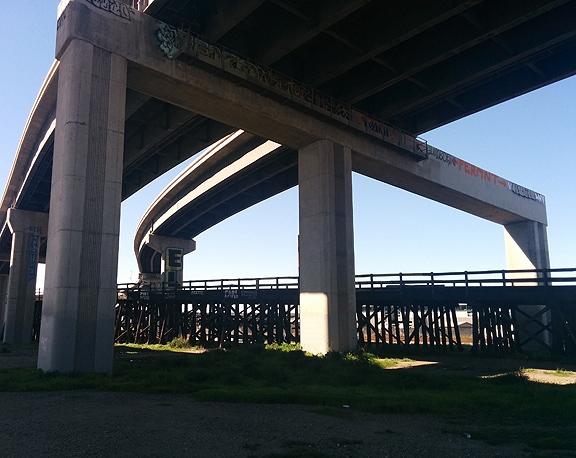 On a March ride with my pal Dave Snyder, we wandered under the freeway ramps near the Bay Bridge and in West Oakland. Weirdly beautiful! Especially because of the old railroad trestle running under it all…
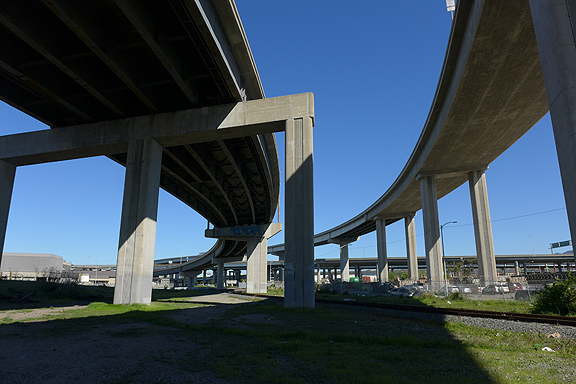 Happy geometries!
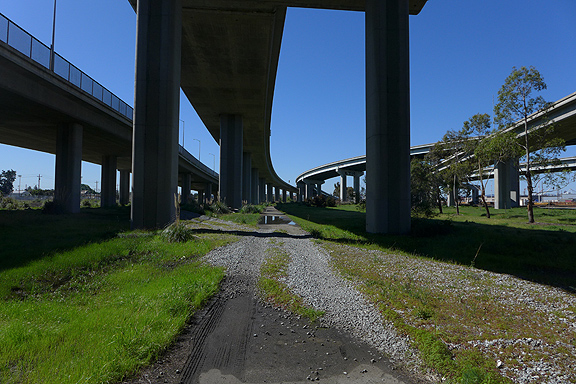 There was even an almost bike path under it all…
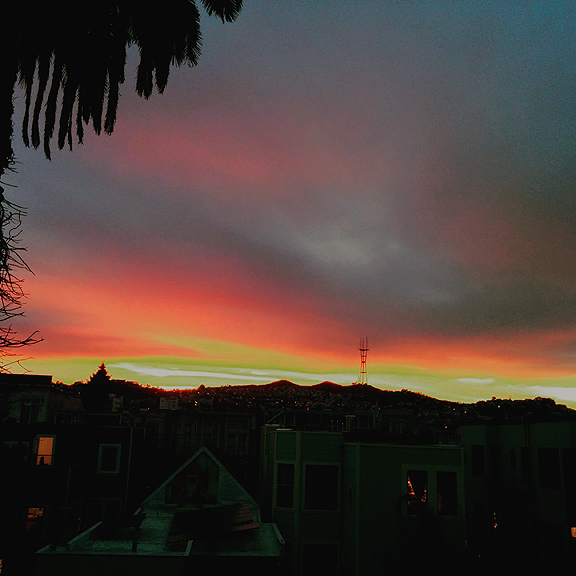 We had a great sunset on Leap Day, Feb. 29, 2016.
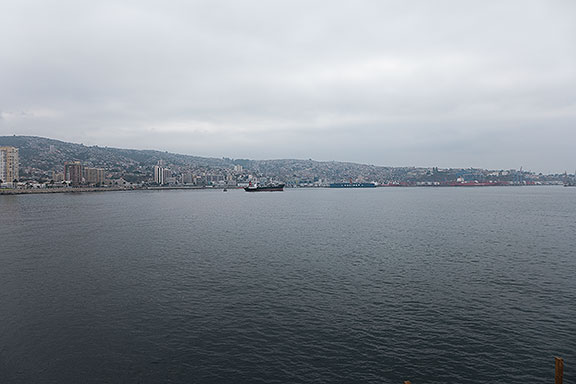 Valparaiso, Chile, view south from fishing pier in bay. Valparaiso, Chile is a spectacularly beautiful city. It seems appropriate that it is a sister-city to San Francisco as it shares the Pacific Ocean and a very hilly topography, along with the historic connection that linked Chile to San Francisco’s Gold Rush in 1849-1850. Chileans were one of the largest populations to arrive in the early days of the Gold Rush, since they were closer, though their presence was quickly overwhelmed by tens of thousands of people from France, Germany, England, the U.S., and elsewhere. There’s no memory of that Chilean connection in San Francisco these days, though as I mentioned in the previous post, a more recent wave of Chileans arrived in San Francisco during the 1970s as refugees from the Pinochet dictatorship.
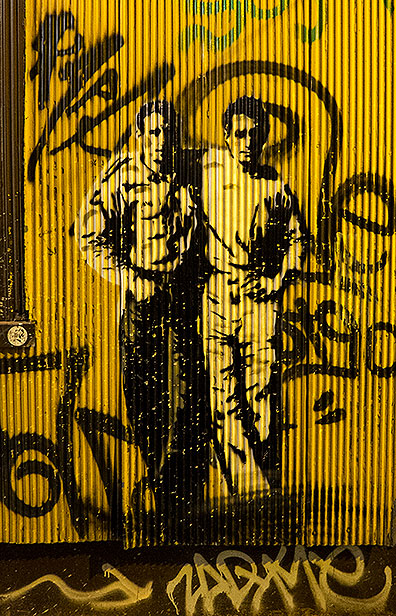 This stencil of Jack Kerouac and Neil Cassady is an iconic image used for years by City Lights Books in San Francisco… and here it was on the walls of Valparaiso, keeping alive the connection between the two cities? If we historicize that a bit more precisely, those Chileans were the first escapees from the harsh imposition of a neoliberalism determined to smash the organized working class. After the 1973 Chilean coup, new military dictatorships from Argentina to Indonesia, South Korea and the Philippines were backed by the U.S. as bulwarks of the “Free World;” at gunpoint they freed markets for international investors by breaking unions and selling off publicly owned assets. Milton Friedman’s “Chicago Boys” provided their throwback economic theories to Margaret Thatcher and Ronald Reagan and their market fundamentalism drove the reorganization of the global order that landed us in the mess we’re in now.
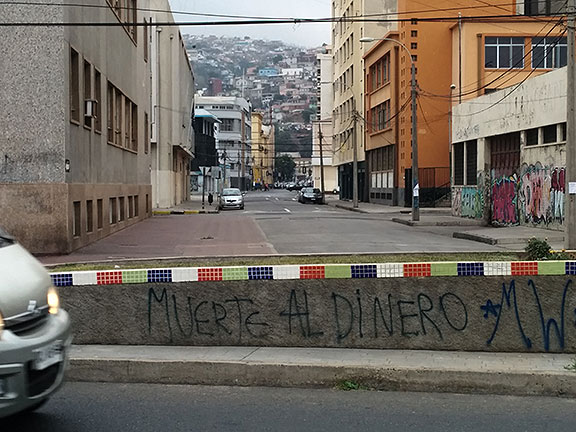 “Death to money” graffiti on coastal boulevard in Valparaiso. I went to Chile full of curiosity to see it and get my first glimpse of its culture and people. My time there was very brief so I can’t make any claims to real knowledge, but I did learn a bit about Chilean history:
- The 1879-83 War of the Pacific with Bolivia and Peru that seized territory rich in saltpeter and copper, and left Bolivia landlocked without the sea coast they had when the war started.
- A brief civil war in the 1891 between the President, backed by the Army, and the Congress, backed by the Navy, won by the latter.
- The curious coincidence between Chilean national politics and California when in 1938 both saw the election of left-leaning Popular Front governments.
Valparaiso, or Valpo as it is sometimes called, had long been a city that I imagined, and the real place did not disappoint, even if my uninformed fantasies proved to be entirely inaccurate. A bustling container port, an elegant dying old financial district, funiculars climbing from commercial lowlands to residential hillside neighborhoods, a seaside bikeway connecting Valpo to nearby wealthy enclave Vina del Mar.
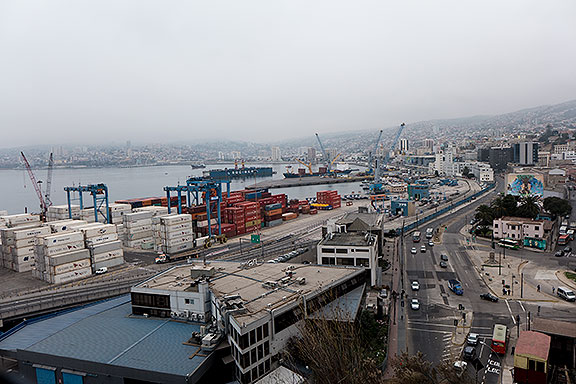 Valpo has a thriving container port. 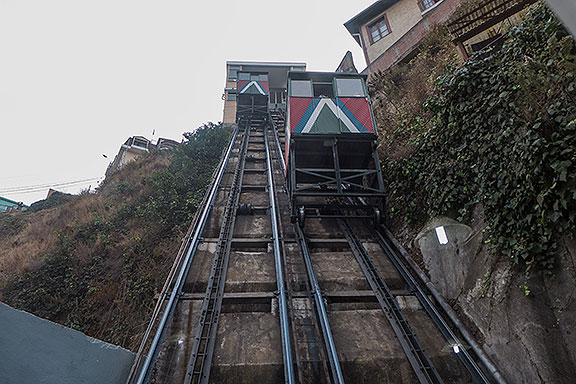 One of many ascensores, or funiculars, traversing the steep slopes. 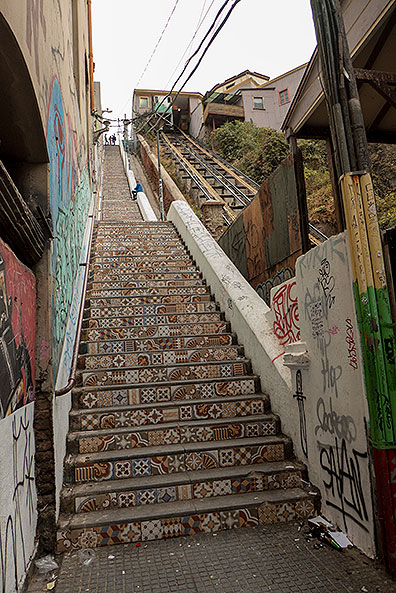 Mosaic-decorated stairs next to another funicular. 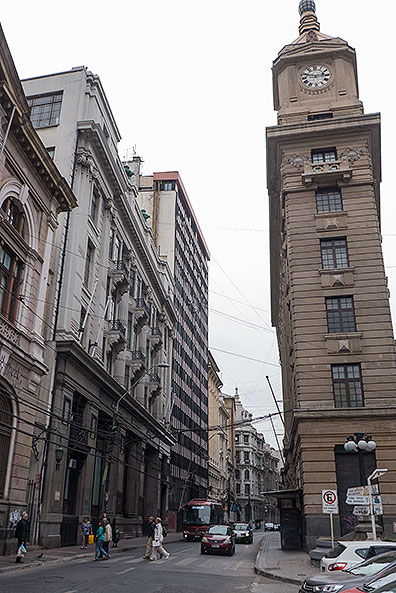 A once-bustling financial district, now rather hollowed out. Some of the hilltop neighborhoods just above the downtown area are rapidly gentrifying while adjacent areas are left mired in the poverty that neoliberal prosperity necessarily produced. Wherever I went walking around Valparaiso’s streets I found street art from graffiti to spraycan murals to sophisticated large works by very talented artists.
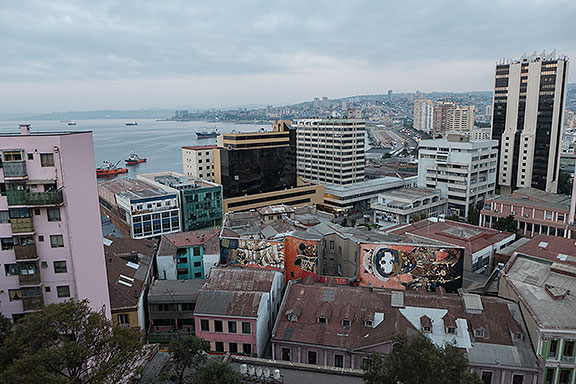 View north from hill above downtown. Gorgeous mural below! 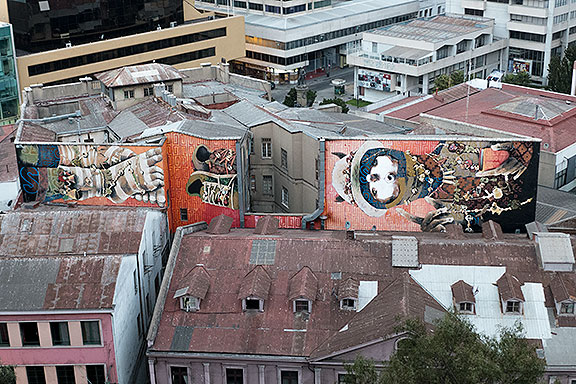 Closer view 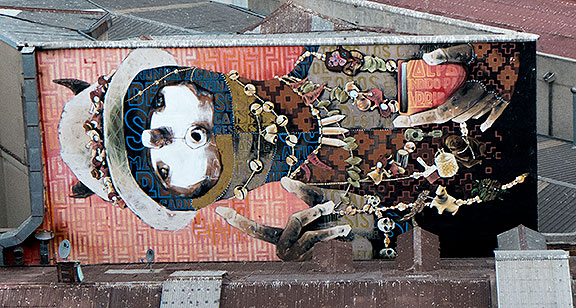 Still closer Continue reading Valparaiso: Getting a Glimpse
|
|































